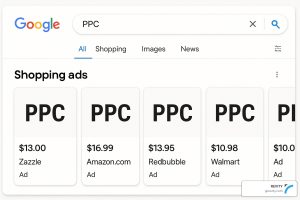The digital marketing landscape has witnessed a revolutionary change with the advent and growth of social media advertising. What started as platforms for connecting with friends and family have now morphed into powerful marketing tools for businesses of all sizes. This transformation of social media into a key marketing space has been rapid and profound, reshaping how companies reach and interact with their audiences.
Social media advertising is a digital marketing approach that uses various social media platforms to promote products, services, and brands to a vast yet targeted audience.
Unlike traditional forms of advertising, social media advertising taps into the rich user data available on these platforms, allowing businesses to target their ads based on specific demographics, interests, and user behaviors. This ability to target audiences precisely makes social media advertising a game-changer in the realm of digital marketing.
Today, the importance of social media advertising is impossible to overstate. It provides an unmatched opportunity for businesses to expand their reach, engage with their audience more intimately, and measure the effectiveness of their campaigns with incredible accuracy.
Here are nine reasons why social media advertising stands out as a vital tool for businesses looking to flourish in the digital ecosystem.
1. Extensive reach and targeted audiences
Social media advertising connects businesses with a vast audience while simultaneously zeroing in on specific groups. Platforms have evolved beyond digital hangouts to become bustling marketplaces with millions of users from all corners of the world. This immense user base opens up opportunities for businesses to broadcast their message far and wide.
Yet, what makes social media advertising truly compelling is the ability to target your ads with laser precision. These platforms provide advanced targeting tools that go beyond identifying basic demographics like age or location. You can tailor your ads to reach people with specific interests, habits, and purchasing behaviors.
For example, imagine you run a gourmet coffee shop. Through social media advertising, you target your ads to reach only those users in your city who are coffee enthusiasts or who frequently visit coffee-related pages. Or, if you’re launching a new line of running shoes, direct your ads to users who are avid runners or follow sports-related content.
This level of targeting is a more intelligent way to use your advertising budget, as you’re not simply casting a wide net and hoping for the best. Instead, you’re engaging with an audience that has already shown an interest in what you have to offer, thereby increasing the chances of engagement and conversion.

2. Cost-effectiveness compared to traditional advertising
For businesses today, especially small and medium-sized ones, the cost-effective nature of social media advertising is a game-changer. Social media advertising is budget-friendly, especially when compared to traditional avenues like television, radio, or print ads.
The major difference in cost comes down to the structure of advertising on these platforms. Traditional media often demands a hefty investment upfront for a spot, which can be a tall order for smaller businesses.
Social media, however, operates on a more flexible and approachable pricing model. You are able to initiate campaigns with a budget that aligns with your capacity and scale up or down based on how your ads are performing.
Let’s take platforms like Facebook or Instagram as examples. Here, you set up an ad campaign with a daily budget that’s comfortable for you, even if it’s a modest amount. This kind of scalability and control over your advertising budget is a significant advantage.
Additionally, social media platforms offer various ad formats. Options like Instagram Stories ads are often less expensive than other types of ads on the platform. However, they still reach a large number of people.
3. Enhanced brand recognition and loyalty
Social media is a powerful ally in making your brand more recognizable and developing a loyal customer base.
Platforms like Instagram and Pinterest are particularly effective for creating and reinforcing a visual identity for your brand. Consistently using your brand’s colors, logo, and style in your advertisements helps to imprint your brand’s image in the minds of your audience and make it more memorable.
In addition to increasing recognition, social media is a valuable tool for nurturing loyalty among your customers. Interacting with your audience through these platforms, such as by responding to comments on your ads, fosters a sense of connection and community. This interaction goes a long way in making customers feel valued and connected to your brand on a personal level.
Offering exclusive deals or content to your social media followers is another great way to build loyalty. Whether it’s a discount code or early access to new products, these special offers make your followers feel like insiders and valued members of your brand family.
Incorporating user-generated content into your advertising strategy also significantly enhances brand loyalty. Showcasing real customers and their experiences with your brand serves as authentic social proof and demonstrates that you value and celebrate your community.

4. Access to rich data and analytics
One of the most underrated features of social media advertising is the wealth of data and analytics it offers. Social media platforms are goldmines of information that provide invaluable insights into your audience and the effectiveness of your advertising campaigns.
Every social media platform has built-in analytics tools that are quite robust. These tools track everything from basic metrics like how many people saw your ad (reach) and how they interacted with it (likes, shares, comments) to more in-depth data such as the number of clicks, conversions, and even detailed user engagement paths. This kind of data gives you a clear picture of who is seeing your ads and how they interact with them.
This information is incredibly useful for any business delving into social media advertising. It gives you a window into your audience’s preferences and behaviors. For example, you might discover that your audience engages more with video content than with images or that your ads get more traction on weekends. These insights guide you to tweak your content or adjust your posting schedule for better engagement.
This data also allows for precise measurement of your return on investment (ROI) in advertising. You can identify which ads are hitting the mark and which ones might need some reworking. Perhaps an ad’s messaging isn’t resonating, or the visuals aren’t catching the audience’s attention. The ability to track these aspects means you are able to continually refine your ads for optimal performance.
Beyond just optimizing individual campaigns, the insights gained from social media analytics also inform your broader marketing strategy. If certain products or messages are getting a lot of positive responses, they might deserve a bigger spotlight in your overall marketing plan.
5. Increased website traffic and higher conversion rates
Social media ads have become a key player in driving more traffic to business websites and boosting conversion rates. Here’s how this dynamic works and why it’s proving to be so effective.
When targeted audiences encounter your ads, they’re more likely to click through to your website. This is because the ad content resonates with their interests or needs. Social media platforms offer various ad formats that make this transition from the ad to your website seamless, such as direct links in stories or posts.
The journey doesn’t end with a click, though. Once the potential customer lands on your website, their experience there significantly influences their decision to purchase or engage further.
Because of this, it’s crucial to ensure that what a potential customer saw in an ad is reflected on your website, whether it’s a featured product, a promotional offer, or a specific message. A smooth, relevant experience on your site helps convert this interested visitor into a customer.
Well-targeted social media ads bring a higher quantity of traffic to your website. But more importantly, they bring much higher quality traffic. Visitors already have some level of interest in what you’re offering; thereby, you’ve already increased the chances of converting these visits into tangible actions like purchases or sign-ups.

6. Quick and direct customer engagement
On top of showcasing your product or service, social media ads open up a direct line of communication with your customers. This kind of immediate interaction is one of the unique advantages of social media platforms.
The interactive nature of social media means that your ads are starting points for conversation. Customers can quickly react, comment, or even pose questions directly in response to your ads. This interaction offers instant feedback and insights into your audience’s thoughts and feelings about your brand and products.
Encourage this interaction right from your ad copy. For example, an ad for a new coffee blend might ask, “What’s your favorite coffee moment?” Such prompts not only engage customers but also gather valuable feedback. It’s a simple yet effective way to make your ads more interactive and engaging.
Another approach is using your ads to invite participation in events or contests. Imagine an ad that encourages customers to post a picture with your product using a specific hashtag. This boosts engagement and creates a community around your brand fueled by user-generated content.
Responding quickly to queries or comments made on your ads also plays a crucial role. When customers use the comments section to ask questions or express concerns, timely and helpful responses greatly enhance customer satisfaction and your brand’s image. It shows that your business values its customers and is attentive to their needs.
7. Staying competitive in a digital-first market
With the majority of consumers and businesses actively engaged online, social media platforms have become essential battlegrounds for brand visibility and customer engagement. Staying competitive often hinges on a business’s ability to leverage social media advertising effectively.
Your current and potential customers are likely spending a significant portion of their time on social media platforms. This shift in consumer behavior presents a massive opportunity for businesses to reach their audience where they are most active.
By not taking advantage of social media advertising, businesses may miss out on engaging with a large and growing audience, potentially ceding ground to more digitally savvy competitors. In a market where consumers are bombarded with information and choices, being able to cut through the noise with personalized messaging is a significant competitive advantage.
Another critical aspect is the speed and agility that social media advertising offers. Trends and consumer preferences change rapidly. Social media platforms provide businesses with the tools to quickly adapt their marketing strategies in response to these changes. This agility enables businesses to stay relevant and responsive to the market, a critical factor in maintaining competitiveness.
8. Versatility of ad formats and creativity
Social media platforms are like playgrounds for advertisers, offering a diverse array of ad formats to get creative with. This variety is a boon for businesses as it allows them to present their messages in the most compelling way possible. There are a myriad of different formats that can be used creatively to make your ads stand out.
Take image ads, for example. They’re straightforward yet powerful, perfect for making a strong visual statement. Then there are video ads, which are excellent for storytelling or showing your product in action, engaging the audience with movement and sound. Carousel ads provide a unique opportunity to showcase multiple products or tell a story across several frames, while stories ads offer a full-screen experience that becomes incredibly immersive.
The trick is to match the ad format to your campaign’s goals and your audience’s preferences. For instance, a video ad is ideal for launching a new product with a bang, while carousel ads showcase different uses of a product in a visually engaging way.
Creativity here is key. Illustrate a narrative with carousel ads or use video ads to take viewers behind the scenes of your business, building a deeper connection. Incorporating user-generated content adds authenticity and relatability. Interactive elements like polls or questions in stories ads make your ads more engaging and provide valuable feedback.

9. Real-time performance tracking and adaptability
One of the most significant advantages of social media advertising is the ability to monitor your ads’ performance while they’re still running. This real-time tracking is a crucial aspect for businesses, offering a window into the effectiveness of their ads and the power to adapt strategies quickly.
Metrics like how many people see your ad, how they interact with it, and whether they’re taking the desired action are readily available. This kind of instant feedback is invaluable. For example, if an ad isn’t getting the clicks you anticipated, you see this in real time and start investigating why.
The ability to track performance as it happens means you can be more adaptable with your marketing strategies. Maybe the wording needs to be more compelling, or perhaps a different image could be more eye-catching. If something in your ad isn’t working as well as you hoped, you have the opportunity to tweak it there and then.
Real-time data allows you to make these adjustments swiftly. Being able to pivot your strategies based on current performance data ensures that your advertising efforts always align with what’s resonating with your audience.
Superior social media advertising with Revity
Mastering social media advertising is crucial in today’s digital-dominated world, but it’s no small feat. With the ever-evolving nature of social platforms, the art of creating engaging and effective ads, and the necessity of monitoring and adapting strategies in real time, social media advertising demands a level of expertise and ongoing attention that can be overwhelming.
That’s where Revity Marketing Agency steps in. We specialize in navigating the complex landscape of digital and social media marketing, providing businesses with the expertise needed to make their mark in this crowded space. Our team deeply understands how different social media platforms work and how to tailor strategies to suit each one, ensuring your advertising efforts hit the mark every time.
At Revity, we aim to create meaningful, engaging experiences that connect with audiences. We’re adept at interpreting real-time data and agile enough to make quick adjustments, ensuring your campaigns are effective and cost-efficient. We work closely with each of our clients, taking the time to understand their unique brand and goals, which allows us to create customized campaigns that truly resonate with their target audience.
In an environment where standing out is key, having Revity Marketing Agency by your side gives you the edge you need. Let us help you harness the power of social media advertising to elevate your brand and drive your business forward.
Let us help you create a strategy that drives real results for your business. Contact Revity today to learn more about how we can help your company succeed on social media!
































